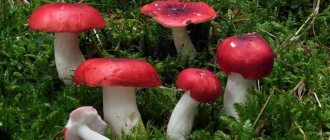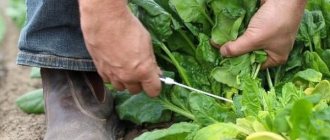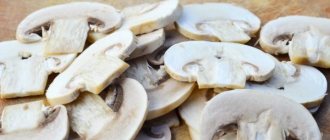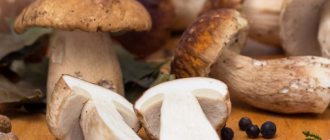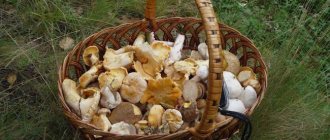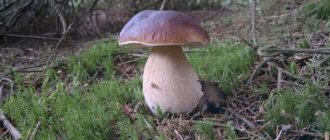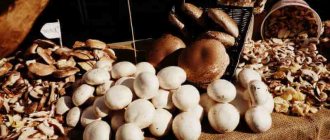Home Mushrooms
If earlier no one asked the question of whether the pig mushroom is edible or not, clearly classifying this mushroom as not only tasty, but also healthy, now mycologists have radically revised their attitude towards these gifts to the forests. Perhaps the information presented in this article will be a revelation for many, but in modern reference books this mushroom is described exactly like this.
- 2 Description of the fat pig mushroom
2.1 Video: different types of pig mushrooms
What do pig mushrooms look like and where are they collected?
Pig mushrooms are called differently: matryoshka, cowshed, fatty or filly. The traditional name comes from the cap's resemblance to a pig's ear. The origin of the remaining folk names is unknown.
Externally, pigfish can easily be confused with valuu or milk mushroom. She has a short thick leg and a fleshy round cap. In young specimens it is convex, but with age it becomes concave and wavy along the edge. Color varies from olive to red-brown. Its intensity depends on the age of the mushroom.
Pigs are found everywhere, in deciduous and coniferous forests, and can sometimes grow even within the city. They can grow either singly or in small groups. Prefers wet or marshy areas.
Where does it grow and when is it found?
Pigs are found in all temperate regions. They are found in deciduous and coniferous forests. They grow on the edges and clearings, along the edges of marshy areas. They can also grow on the roots of trees that are uprooted. Mushrooms begin to grow in July, and the last mushrooms can be found in the first ten days of October. Reproduction of pigs occurs with the help of spores. Svinushka is a type of mushroom from the Svinushka family. About three decades ago it was listed as a conditionally edible mushroom, but currently it is included in the list of poisonous ones.
Pig has many names that are used in certain areas of our country. The most common ones include: cowshed, dunka, pig farm and some others. The pigweed can be found almost everywhere; it prefers to grow in deciduous or coniferous forests. Favorite places of growth are forest edges next to clearings and the outskirts of swamps. Most often, a cowshed can be found where birches, oaks and shrubs grow.
Where does the pig grow and when is it found?
Often svinushka or dunka grows on uprooted tree roots. A distinctive feature of the mushroom is that it very rarely grows alone. More often it can be found in small groups. The pig loves moisture, including moist soil, and is found in the summer-autumn period, from July to October. Pigweed is characterized by abundant and frequent fruiting.
Interesting read: Doubles again
Features of the mushroom
Until the 90s of the last century, pig mushrooms were classified as conditionally edible mushrooms. Modern scientists have proven that eating them is harmful.
Important! Substances that can reduce the number of red blood cells in the blood have been found in the pulp of the mushroom. In addition, pigs can cause serious poisoning, in some cases fatal.
The classification of pig mushrooms as poisonous mushrooms is explained by some features of the species:
- Mushrooms contain a special antigen, due to which consumption of fried or boiled pulp provokes the production of antibodies by the human immune system.
- The rate of antibody formation depends on the individual characteristics of the organism. For some they provoke rapid poisoning and allergic shock, for others they accumulate in the body for a long time.
- Toxins accumulated in the body impair kidney function, and symptoms of the disease may not appear until several years later. The increased content of toxins causes acute renal failure, which often ends in death.
Those who still dare to collect pig mushrooms should remember that this mushroom is able to survive even in a very polluted environment. It is for this reason that pigs often grow on city lawns and even in environmentally unfavorable regions. In addition, fly larvae and other insects often lay in the pulp of the mushroom.
Nutritional value and chemical composition
- calories – 30 kcal per 100 grams (1.91% of normal);
- proteins – 3.7 g (3.94% of normal);
- fats – 1.7 g (2.46% of normal);
- carbohydrates – 1.1 (0.77% of normal).
Includes:
- B vitamins (B1, B2, B4, B5, B6, B9);
- vitamin PP;
- potassium;
- calcium;
- magnesium;
- sodium;
- phosphorus;
- iron;
- manganese;
- copper;
- selenium;
- zinc.
Description of species
There are several types of pigs. Some of them are clearly poisonous, others can be edible with certain heat treatment.
Thick pig (felt)
Until recently, this particular variety was considered suitable for human consumption. The only option to prepare felt pork is to salt or marinate it. In any other form, the pulp is too hard.
Important! Modern scientists do not recommend eating this mushroom because of dangerous toxins that can cause significant harm to the body.
Externally, the mushroom looks like this:
- The cap is large, up to 20 cm in diameter. The edges are folded inward;
- in young specimens the cap has a regular rounded shape, but with age it becomes disproportionate;
- the skin is velvety, brown or olive-brown;
- the pulp is watery, yellowish, and has no distinct odor;
- the leg is short, brown or olive;
- under the cap there are light yellow plates. When pressed they turn brown.
In the past, felt pigs were partly consumed as food. Some mushroom pickers still believe that young specimens can be cooked: salted and canned. But even if you peel the mushrooms, wash off all the debris from their surface and cook them, the flesh will remain bitter and potentially harmful to health.
Thin pig
Another dubious variety. The ripening season for fruiting bodies occurs in late summer and autumn. Found in coniferous and deciduous forests.
Important! Previously, thin pigs were considered edible. But in 1944, German mycologist Julius Schaeffer died from eating these mushrooms, after which they began to be considered deadly.
The external differences of the mushroom are:
- the cap is olive-brown (in young mushrooms) and rusty-brown with a gray coating - in old ones. Diameter from 12 to 20 cm;
- the pulp is dense, pale yellow, becoming loose with age;
- the leg is cylindrical, no more than 6 cm in height;
- under the cap there are wide and sparse plates.
Pig ear-shaped (panus-shaped)
This mushroom is dangerous because it is poisonous and looks similar to the edible oyster mushrooms.
The ear-shaped pig has the following features:
- grows on dead coniferous trees, sometimes it can grow on wood chips;
- the shape of the cap resembles a fan, colored brown or orange;
- there is no stalk, and its role is played by a short lateral process.
This variety of pig has a distinct mushroom smell, but it should not be eaten due to the risk of poisoning.
Other types
There are several more poisonous varieties in the pig family:
- Alder: got its name due to the fact that it grows on the trunks of alder and aspen. The cap has the shape of a concave funnel and is colored yellow or brownish. The pulp is dense, yellowish, without a distinct smell or taste.
- Pigweed Paxillus obscurisporus: found in clearings, forest edges and pastures from early spring until the first autumn frosts. The cap is golden brown, with a raised brim. The leg is no more than 8 cm in height, gray or yellowish in color. It has a pleasant mushroom smell, but is not suitable for human consumption.
Primary processing and preparation
If you nevertheless decide to cook the mushroom, to finally decide for yourself whether it is edible (which is very dangerous), you should first soak the fruits for 1–2 days, periodically changing the water. The second method: keep it in salted water for 5 hours, during which time it should be changed 3 times.
It will also take a long time to cook the mushrooms, preferably twice for 30 minutes each with changing the water. During the repeat process, add salt to taste. After this, the pork can be fried or marinated.
The recipe for the first method is this. Ingredients:
- boiled mushrooms – 0.5 kg;
- onion – 200 g;
- butter – 50 g;
- salt, pepper to taste;
- favorite greens, optional.
Cooking phases:
- Melt butter in a frying pan, add diced pork.
- Fry over medium heat for 7 minutes.
- Finely chop the onion and add to the mushrooms.
- After 10 minutes, add salt and pepper.
Remove the mixture from the heat, sprinkle with herbs and serve with boiled potatoes.
In order to marinate felt pigs, you will need:
- mushrooms – 1 kg;
- salt – 1 tbsp. l.;
- sugar – 2 tbsp. l.;
- vinegar - 3 tbsp. l.;
- vegetable oil – 6 tbsp. l.;
- black peppercorns – 15 grains;
- laurel leaves – 3 pcs;
- cloves – 3 pcs;
- water – 600 ml.
How to cook:
- Add all the spices to the water and bring to a boil.
- When the salt and sugar are completely dissolved, you can add the mushrooms.
- Boil for 15 minutes, remove from heat.
- Place the fruits in sterilized jars.
- Remove bay leaves from the marinade and pour the product over them.
After this, you can sterilize the jars for 20 minutes and roll them up with metal lids or close them with high-quality nylon lids. After cooling completely, take it to a cool room or place it on the bottom shelf of the refrigerator. After 3 days you can try.
IMPORTANT!
Consumption of mushrooms that have not been fully studied is dangerous to life and health. They should not be given to children, the elderly, or those with gastrointestinal diseases.
The benefits and harms of pigs
For a long time, pig mushrooms were considered conditionally edible mushrooms. They could be eaten salted or after prolonged heat treatment.
Modern scientists have proven that the pulp of these mushrooms contains dangerous toxins. They can accumulate in the body and cause severe poisoning and kidney failure.
But pigs can also be useful. Scientists have discovered that they contain the natural phenolic compound atromenthin. It can cause the death of leukemic cells, so it is used in the fight against blood and bone marrow cancer.
How long to cook pork
Since today we know for sure that it is impossible to eat pork, we will describe the cooking method that was used by our ancestors.
Preparatory activities before preparations:
- Wash the mushrooms.
- Leave for 3 hours in cool water.
- Cook for half an hour.
- Drain the broth.
Next, they are fried. Previously, they were salted and pickled for the winter. They are not suitable for first courses, and they cannot be dried either.
About the edibility of pig mushrooms
Until the middle of the last century, pigs were very often eaten after pre-salting. When eaten fresh, they cause serious digestive upset.
Reference! You can still find culinary recipes that contain pigs. Most likely, they were taken from old books, since modern scientists strongly do not recommend eating these mushrooms.
In fact, pigs can actually cause fatal poisoning. Therefore, it is better for mushroom lovers to collect those varieties that are guaranteed to be eaten: boletus, boletus, honey mushrooms and boletus mushrooms.
Edible mushrooms that pigs are confused with
Pigs have a characteristic cap shape, so it is difficult to confuse them with other species.
Inexperienced mushroom pickers may confuse it with the following species:
- Volnushka belongs to the Milky family and requires long soaking before cooking. The most popular variety is the pink wave, the description of which will help to distinguish it from the pig. This mushroom reaches gigantic sizes (cap diameter is up to 15 cm). The edges of the cap are turned down and have a slight edge. The pulp is white, sometimes acquiring a pink tint. The fruiting bodies are dense and are not damaged during transportation.
- Oyster mushrooms, like pig mushrooms, grow on trees and stumps. The difference between them is that the oyster mushroom has a smooth edge of the cap and does not have a depression in the center.
Important! When going into the forest, it is important to learn to distinguish edible varieties from poisonous ones. To do this, you need to study pictures of mushrooms, or better yet, go into the forest with an experienced mushroom picker.
Interesting Facts
Fat pig contains telephoric acid, which is a blue pigment. This allows the mushroom to be used to dye various fabrics, especially wool, blue-gray.
Although pigs have been consumed in Russia for a long time, most of them are gradually classified as poisonous. After all, science does not stand still and is constantly studying the components of different mushrooms. It is also worth noting the deterioration of the general ecology of the planet and the weakening of the immunity of the majority of the inhabitants of the Earth. Eating this mushroom becomes dangerous.
How can this mushroom be dangerous?
The main danger of pork is that the toxins it contains do not lose their properties even after prolonged heat treatment.
The pulp of this mushroom contains a special antigen. It binds to human cell membrane structures. As a result, the immune system considers them hostile and begins to attack such cells. This leads to destruction of red blood cells and subsequent kidney failure.
In addition, pigs grow almost everywhere, including in places with poor ecology. Heavy metals and radioactive isotopes accumulate in their pulp, causing serious poisoning.
What could be the consequences?
Pigs are dangerous in any form. When eaten fresh, they quickly cause digestive upset, the intensity of which depends on how many mushrooms were eaten. But even if you pour hot marinade over the mushrooms and roll them into a jar, the toxins from the pulp will not disappear and over time can seriously affect your health.
Toxic properties of the mushroom
The antigen contained in the pulp causes an autoimmune reaction. It is expressed in the fact that cells of the immune system attack red blood cells.
Important! The effect of the antigen is manifested by repeated consumption of mushrooms. Some people develop an autoimmune reaction after years of eating pork.
Symptoms appear fairly quickly. First, abdominal pain, vomiting and diarrhea appear. Further, the volume of blood and urine decreases, and the level of hemoglobin drops. Over time, this leads to serious complications, including acute renal and respiratory failure.
It is important to remember that today there is no antidote for pig poisoning. The patient is prescribed maintenance therapy. This includes regular blood tests, adjusting fluid and electrolyte balance, and supporting kidney function.
Poisoning with pork belly
In case of poisoning with thin pig, symptoms do not develop immediately, most often in the case of repeated consumption of it. The severity of poisoning depends on how much of them were eaten, as well as on the person’s health. The highest risk groups are children and people with weakened immune systems.
Poisoning with pigweed is characterized by the following symptoms: pain in the abdomen, vomiting, diarrhea, yellowness of the skin, a sharp decrease in urination, and an increase in the level of hemoglobin in the urine.
Answers to questions from mushroom pickers
The main question for mushroom pickers regarding pigs is whether they are edible or not. The answer is clear - they are dangerous to eat, regardless of the method of preparation. Fans of salted or pickled forest mushrooms should give preference to the edible counterparts of sow mushrooms - saffron milk caps, volnushki or honey mushrooms.
The harmfulness of pigs has been proven by modern scientists. To avoid irreversible negative health effects, you should avoid consuming these mushrooms. You should not believe recipes that tell you that it is enough to clean, wash and salt the pigs to eliminate toxins. This is deadly, so it is better to give preference to collecting sponge mushrooms (boletus mushrooms, boletus mushrooms, etc.), which are guaranteed to be suitable for consumption.
How to cook
You've probably seen pig dishes in photos or in real life many times. These mushrooms look delicious. But to cook them, it’s not enough to wash them and throw them into a dish, like champignons or oyster mushrooms.
The recipe for making dunka is as follows:
- Before cooking, the pigs are soaked in cold water for 2-3 hours.
- Then they are boiled for 30 minutes. To test for toxicity, you can add onions during cooking.
- Then the mushrooms are fried, marinated, and salted. As a rule, this type is not suitable for soups or for drying. But as an individual taste preference, an exception can be made.
But we note that now it is not recommended to cook pork in any form. When consuming dunka, symptoms of poisoning may appear after a certain time. They are accompanied by vomiting, bloating, and diarrhea. Over time, the symptoms only progress.
There is currently no antidote for pigweed toxin.
Edible or not
Dunki mushrooms were used as food in Central and Eastern Europe until the mid-20th century and did not cause food reactions or poisoning. The mushroom was eaten after salting. In its raw form, it irritated the gastrointestinal tract but was not fatal.
There are still cooks who call for soaking dunki, draining the water, boiling and serving. They even provide various culinary recipes, which apparently were taken from 20th century literature and modified for modern cuisine.
If you think that risk is a noble cause, then do not pay attention to scientific works and deaths that prove that pigweeds are poisonous mushrooms that cause poisoning. There are many other types of mushrooms that also grow in forests, but are safe for humans.

